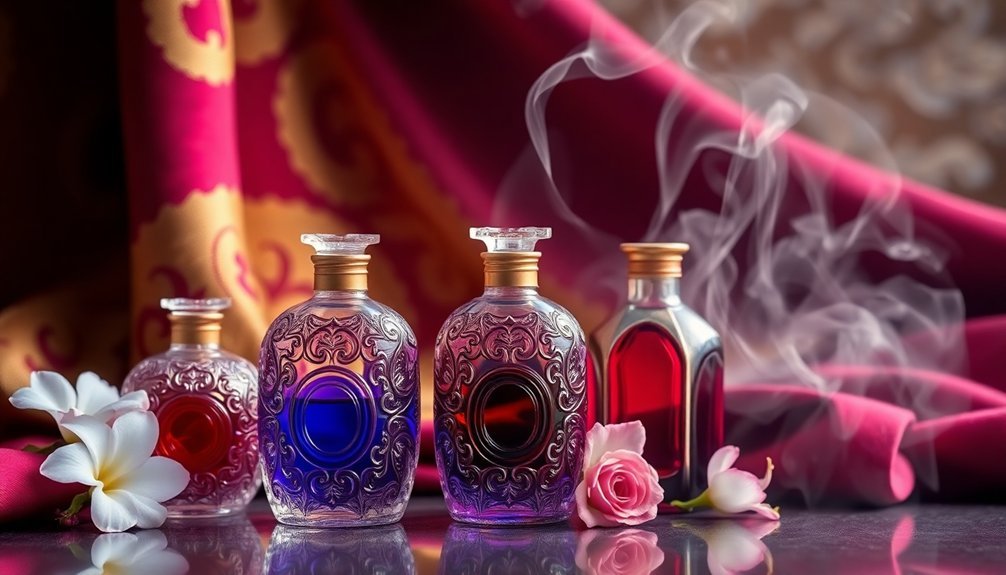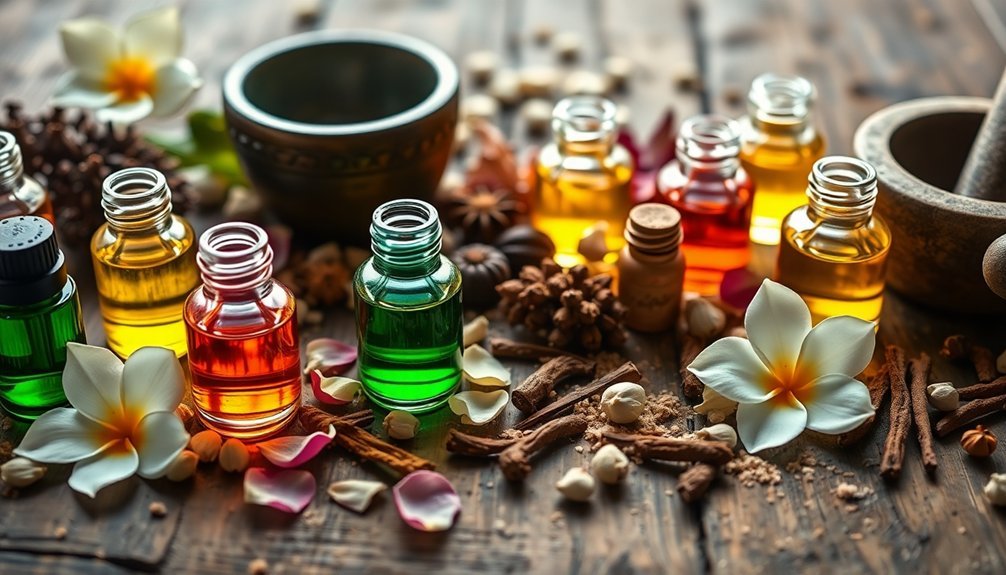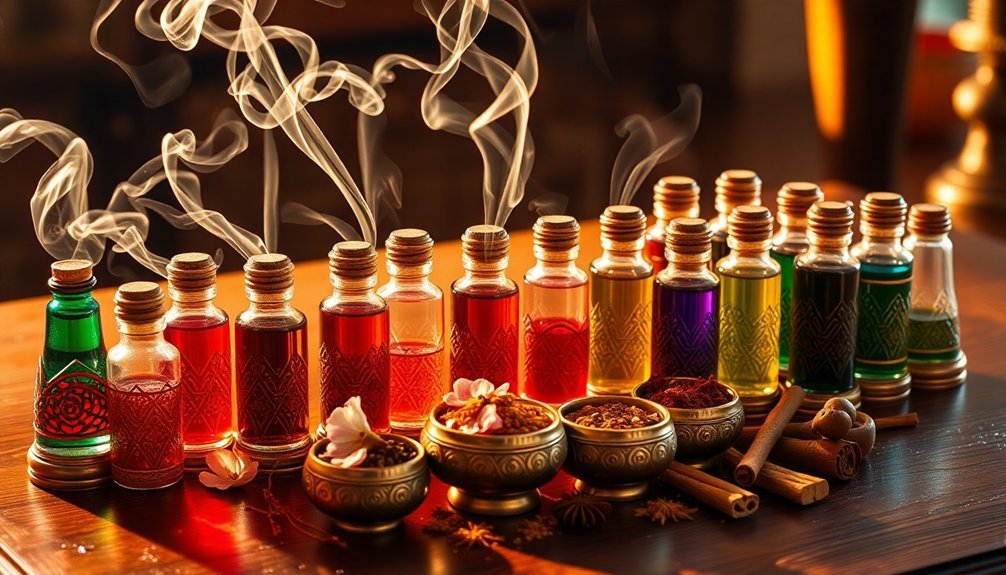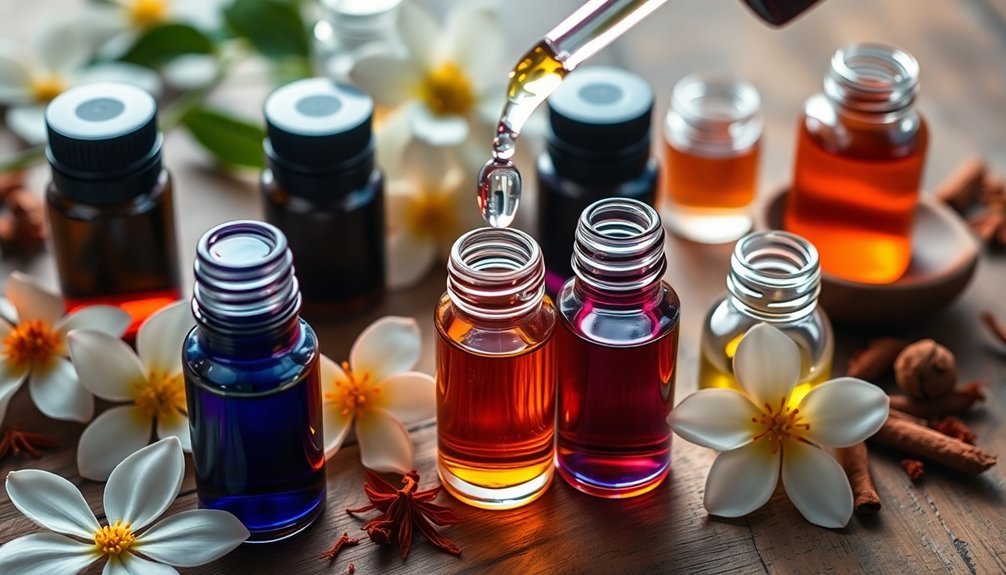To master Oriental perfume blending, you'll need to work with four essential categories: rich resins, exotic woods, warm spices, and sweet elements. Start by layering base notes like amber, oud, and sandalwood, then carefully incorporate spices such as cardamom and cinnamon. Add complexity with frankincense and myrrh, while using vanilla and tonka bean for sweetness. Let each layer settle before adding the next. The art of Oriental perfumery holds many more aromatic secrets waiting to be discovered.
Understanding the Magic of Oriental Notes

While modern perfumery encompasses countless fragrance families, oriental notes stand as pillars of luxury and mystique in the aromatic world.
You'll find their roots stretching back to the Middle Ages when Crusader Knights returned from the East with exotic spices and ingredients.
These notes are characterized by their opulent, warm, and sensual qualities, often featuring rich combinations of spices, resins, and woods. The vanilla and cinnamon notes prominently featured in oriental fragrances create an exotic and enchanting aroma.
You'll typically discover them in a perfume's base notes, where they add remarkable depth and staying power.
François Coty's "Ambre Antique" from 1908 pioneered the modern oriental fragrance category, but it was Guerlain's "Shalimar" in 1925 that truly captured the public's imagination.
The notes blend seamlessly with other fragrance families, making them incredibly versatile despite their intense nature.
Essential Ingredients for Oriental Perfume Making
You'll discover that successful oriental perfumes rely heavily on rich base notes like oud, amber, and sandalwood as their foundation.
To create depth and character, you'll need to carefully balance warm spices such as saffron, cardamom, and cinnamon with these base notes. These sophisticated blends are often based on secret family recipes that have been carefully preserved across generations.
The magic happens when you incorporate resinous materials like frankincense, myrrh, and labdanum, which add complexity and staying power to your oriental blend.
Core Oriental Base Notes
The foundation of any oriental perfume lies in its carefully selected base notes, which provide depth, longevity, and the signature oriental character.
You'll discover four essential categories that form these rich base notes: resins and ambers, woods and incense, spices and herbs, and sweet gourmand elements.
In the resin family, you'll work with amber, labdanum, and frankincense for their warm, musky qualities. Following traditions dating back to when Crusader Knights returned with exotic ingredients from the East, these elements remain foundational to oriental perfumery.
Woods like oud and sandalwood create depth, while spices such as saffron and patchouli add sensual dimensions.
Don't overlook the importance of sweet elements – tonka bean, honey, and benzoin can transform your blend into a luxurious masterpiece.
The key is balancing these elements.
Start with one note from each category, then adjust until you've achieved the perfect oriental signature that's both complex and harmonious.
Balancing Spice Elements
Spices serve as the vibrant heart of oriental perfumery, bringing warmth, depth, and sensual allure to your fragrance compositions. When crafting oriental scents, you'll want to master the delicate balance of spices like black pepper, cardamom, cinnamon, clove, and nutmeg.
These elements work harmoniously with oriental bases such as resins, vanilla, and amber to create rich, memorable fragrances.
- Black pepper and cardamom add complexity and heat while maintaining sophistication.
- Cinnamon and clove enhance warmth and sensuality, as demonstrated in classic perfumes like Opium.
- Nutmeg bridges the gap between spicy and gourmand elements, perfect for adding edible qualities.
Remember to contemplate the intensity of each spice and how it'll interact with other components.
You'll find that proper spice integration creates depth while avoiding overwhelming the overall composition.
Resinous Ingredients Matter
Moving beyond spices, resinous ingredients form the backbone of oriental perfumery, providing deep, lasting foundations that anchor your fragrant creations.
You'll find essential resins like frankincense, benzoin, and myrrh adding rich, balsamic qualities to your blends while serving as natural fixatives.
When you're crafting oriental perfumes, these resins do more than just enhance longevity – they bring mystical, complex dimensions to your fragrances.
Consider how Byredo's Oud Immortel masterfully combines oud with patchouli, or how Serge Lutens' Borneo 1834 achieves depth through myrrh and patchouli.
You can incorporate copahu balm for its antibacterial properties or galbanum for its therapeutic benefits.
The key is understanding how these ingredients work together to create that signature oriental warmth and sophistication your perfumes need.
Preparing Your Oriental Blend Workspace
Creating a dedicated workspace is essential for crafting oriental perfume blends with precision and care.
You'll need a clean, organized desk with proper storage shelves for your precious resins, oils, and pre-dilutions. Set up your digital scale that measures to 0.01g accuracy, and keep your metal spatulas and pipettes within easy reach.
Safety comes first when working with oriental perfume ingredients. Don't forget to wear protective gloves, safety glasses, and a mask when handling potent materials.
Keep your lab notebook close to record every measurement and observation.
- Arrange your ingredients alphabetically on shelves, using perfumery racks for current project materials
- Store your dilutions and blends in properly labeled bottles with eye-droppers for precise handling
- Maintain a clean workspace with protective covering and proper ventilation to prevent cross-contamination
Basic Oriental Perfume Blending Techniques

When creating oriental perfumes, you'll want to start by layering your richest base notes first, typically beginning with amber, vanilla, or precious woods as your foundation.
You can achieve the signature oriental accord by maintaining careful ratios between these heavy base materials – generally using 2 parts amber to 1 part vanilla and 1 part woods.
It's essential to let each layer settle before adding the next, allowing you to evaluate the balance and make precise adjustments to capture that classic oriental character.
Layering Base Notes First
To master Oriental perfume blending, you'll need to start with a strong foundation of base notes that anchor your fragrance.
Begin by applying these rich scents to freshly showered skin, focusing on your pulse points like wrists, neck, and décolletage. Choose classic Oriental base notes such as musk, vanilla, or sandalwood, and remember that these will interact uniquely with your skin chemistry.
- Start with a light application and build intensity gradually to avoid overwhelming the composition.
- Allow base notes to settle for several minutes before adding middle and top notes.
- Test combinations on your skin to verify harmonious blending, as each person's chemistry is different.
For the best results, apply your chosen base note right after showering, when your skin is most receptive to absorbing and melding with the fragrance.
Balancing Oriental Accord Ratios
Building upon your foundation of base notes, mastering the art of Oriental accord ratios takes your perfume blending to new heights. Start with the classic 30-50-20 ratio (top, middle, and base notes), but don't feel constrained by these numbers. You'll want to begin with small quantities, typically 5 drops, to perfect your blend before scaling up.
| Note Type | Typical Ratio | Common Ingredients |
|---|---|---|
| Top Notes | 30% | Bergamot, Sweet Orange |
| Middle Notes | 50% | Ginger, Clove, Rose |
| Base Notes | 20% | Vanilla, Amber, Sandalwood |
| Blenders | As needed | Lavender, Citrus |
| Fixatives | As needed | Vetiver, Benzoin |
Let your blend mature for several days before making final adjustments. Document each combination carefully to replicate successful formulations and learn from less successful attempts.
Creating Your First Oriental-Woody Base
The foundation of any oriental-woody perfume lies in mastering its complex base notes.
You'll want to start by combining vanilla and tonka bean to create a sweet, balmy foundation. Add myrrh and frankincense to introduce resinous depth, then layer in benzoin for its rich, temple-like qualities.
To build your first oriental-woody base, consider these essential combinations:
- Begin with a core accord of tonka bean, vanilla, and labdanum to establish the characteristic oriental sweetness.
- Integrate woody elements like sandalwood and cedarwood, using vetiver as a natural fixative.
- Balance the composition with frankincense and benzoin, adding oud for an exotic touch if desired.
Fine-tune your blend by adjusting the ratios until you achieve the perfect harmony between sweet, woody, and resinous notes.
Mastering Oriental-Spice Combinations

Crafting oriental-spice combinations requires a delicate balance between warm, sweet, and fresh elements.
You'll want to start with classic notes like vanilla, which adds depth and sweetness, while incorporating warm spices such as cinnamon, cardamom, and cloves to create that signature oriental character.
To build your blend, start with a light base fragrance, then layer in your spicy middle notes.
Top it off with rich elements like amber or vanilla to enhance longevity.
You can create sophisticated combinations by pairing rose or jasmine with oud and vanilla, or try mixing citrus notes with woods for a fresh yet grounding effect.
For inspiration, look to successful fragrances like Donna by Valentino or Spicebomb Night Vision, which masterfully balance fresh top notes with warm, spicy hearts and rich base notes.
Enhancing Your Blend With Complementary Notes
Successfully enhancing oriental perfume blends requires a thoughtful selection of complementary notes that work in harmony with your base composition.
You'll find that spicy notes like clove, cinnamon, and pink pepper can add warmth and depth, while woody elements such as sandalwood and oud create a solid foundation.
For a modern twist, consider incorporating sweet gourmand notes like vanilla, tonka bean, or even dark chocolate.
- Blend floral notes like jasmine, rose, or orange blossom to soften intense oriental bases and create a more balanced composition.
- Layer spicy notes strategically, using pink pepper in top notes and nutmeg or cardamom in heart notes for complexity.
- Combine woody elements with sweet notes, such as sandalwood with vanilla or oud with tonka bean, to achieve depth and richness.
Testing and Adjusting Your Oriental Creation

Perfecting your oriental creation demands a systematic approach to testing and modification.
Begin by using blotter strips to test different combinations, dipping them according to the red line guides and allowing them to dry for 10 seconds before evaluating.
Start with two or three materials to form your blend's heart, mixing equal proportions initially. You'll want to adjust components until you achieve the desired harmony.
Add modifiers drop by drop, keeping labeled samples for reference, and use blenders like bergamot or lavender to balance the composition.
Finally, incorporate fixatives carefully to add depth and dimension. Let your creation mature for at least a week to allow the chemicals to interact properly.
Track your adjustments in a spreadsheet and fine-tune the concentration with ethanol to achieve your desired strength level.
Storing and Preserving Your Oriental Perfume Blend
Proper storage determines the longevity of your oriental perfume blend.
You'll want to keep your creation in a cool, dark place around 60 degrees Fahrenheit, away from direct sunlight and temperature fluctuations. A dedicated drawer or cabinet shelf works perfectly, but avoid bathroom storage where humidity and temperature changes can degrade your blend.
- Store your blend upright in its original bottle and packaging, protecting it from light exposure and oxidation.
- Keep your perfume away from windows, radiators, and air conditioning units to maintain consistent temperature.
- Use airtight containers or bags for additional protection, and watch for any signs of discoloration.
Frequently Asked Questions
Can Oriental Perfumes Trigger Allergies or Skin Sensitivities?
Yes, you can experience allergic reactions to oriental perfumes, including contact dermatitis, skin rashes, and pigmentation changes. Common triggers include linalool, limonene, and essential oils in these fragrances.
How Long Does a Homemade Oriental Perfume Blend Typically Last?
Your homemade oriental perfume can last 1-3 years when stored properly, while on your skin, it'll typically last 4-8 hours. Quality ingredients and proper storage conditions will maximize its longevity.
Are There Vegan Alternatives for Traditional Oriental Perfume Ingredients?
Yes, you'll find many vegan alternatives for oriental perfumes. You can use synthetic amber, sustainable woods, plant-based resins, and natural spices to create cruelty-free blends that match traditional oriental fragrances' depth and richness.
What Temperature Should Oriental Perfume Blends Be Stored At?
You'll want to store your oriental perfume blends at 15-20°C (59-68°F). Don't let them get warmer, as heat causes rapid evaporation. Keep them in a temperature-controlled space like a closet or drawer.
Can Oriental Perfumes Be Mixed With Synthetic Fragrances?
Yes, you can mix oriental perfumes with synthetic fragrances. You'll find that synthetics like Hedione and Ambroxan can enhance stability, boost natural notes, and add longevity while maintaining the oriental character you're seeking.
In Summary
Now that you've mastered the basics of oriental perfume blending, you're ready to create your own signature scents. Don't be afraid to experiment with different combinations of woods, spices, and resins while staying true to traditional oriental principles. Remember to keep detailed notes of your successful blends, store them properly, and let them mature. Your journey into oriental perfumery has only just begun.
References
- https://www.kusharomaexports.com/blog/mini-guide-to-perfumes-with-kush-aroma-essential-oils/
- https://mhs.milfordk12.org/ourpages/auto/2020/1/15/12784324316041332238/294751235.pdf
- https://www.birrafragrances.com/blogs/news/the-art-of-mixing-colognes-a-guide-to-creating-unique-scents
- https://eclass.uoa.gr/modules/document/file.php/ISLL125/MLA+Handbook+for+Writers+of+Research+Papers.pdf
- https://www.fragrenza.com/blogs/notes-in-perfumery/oriental-notes-in-perfumery
- https://www.perfumedirect.com/blogs/news/what-are-oriental-fragrances-how-to-choose-one
- https://setaracosmetics.it/blogs/fragrant-journeys/oriental-vs-western-fragrances-discover-what-sets-them-apart
- https://www.cotebougie.com/blog/en/oriental-perfume/
- https://parfumplusmag.com/uncategorised/the-fantastic-oriental-fragrances/
- https://parfum.ae/blogs/news/perfume-ingredients-what-makes-arabian-perfumes-unique





Leave a Reply